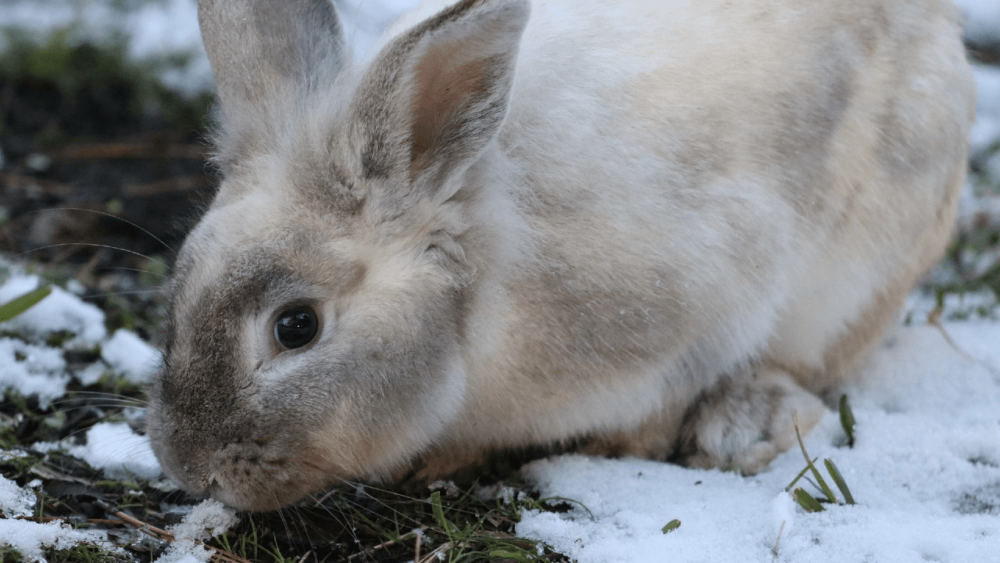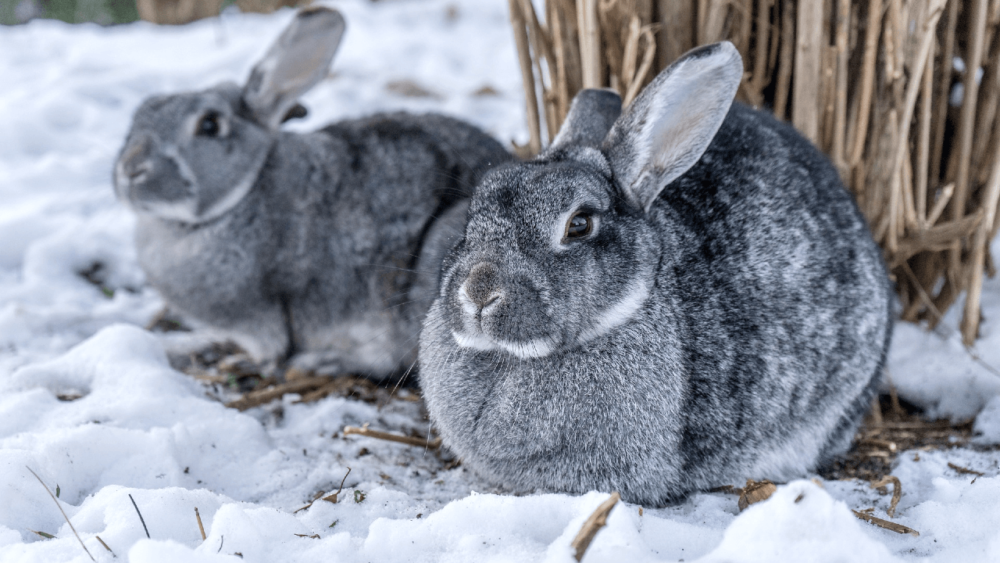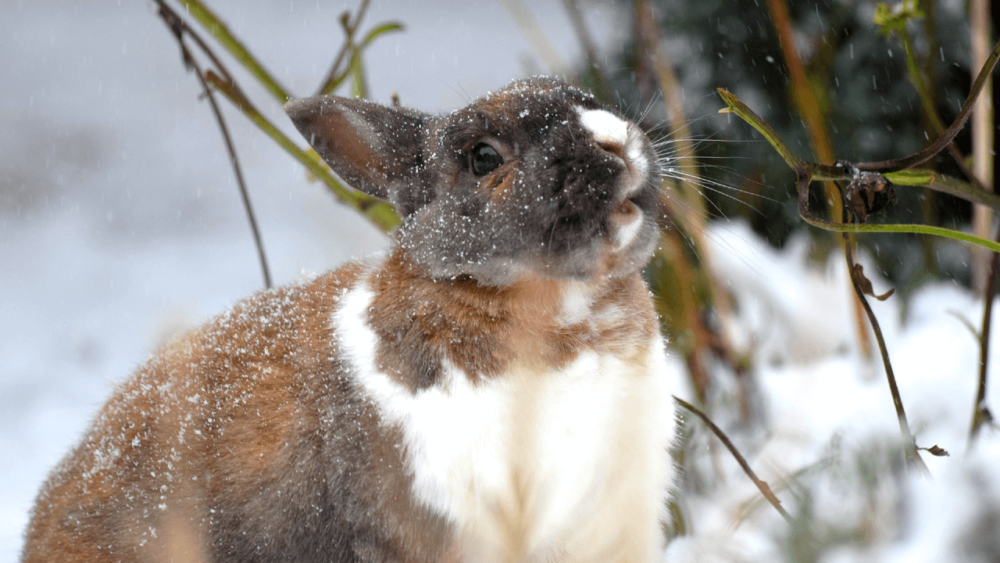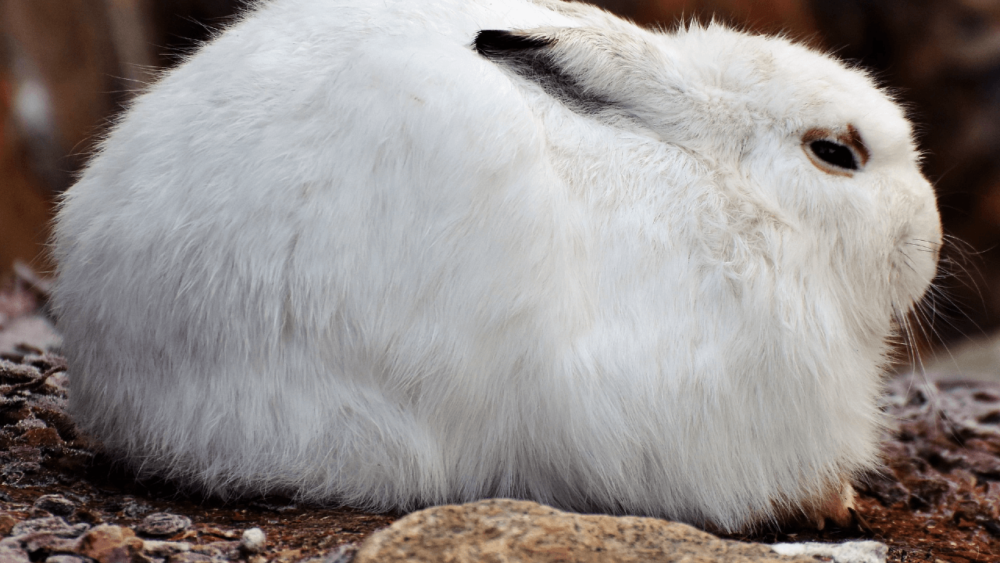As winter approaches, you may be wondering how you can keep your rabbits safe and healthy. Rabbits love outside time, so even if your rabbit is an indoor pet, it’s essential to know about safe winter care.
How cold can rabbits survive? Despite their cuteness, rabbits are reasonably hardy, weather-resistant animals. A healthy adult rabbit can survive in temperatures down to almost 20oF or -6oC with proper shelter. However, without sufficient shelter, temperatures such as these can put rabbits at risk of severe and life-threatening health conditions.
This article will cover everything you need to know on rabbit temperature tolerance, including how to keep your rabbit warm in the winter and answers to some frequently asked questions.
The Ideal Temperature For Rabbits
The ideal environmental temperature for rabbits is around 60–65° Fahrenheit or 15-18° Celcius. That said, rabbits can tolerate temperatures a lot colder than that. However, they are not great lovers of the heat and tend to start feeling hot with anything around 85°F or 30°C. Prolonged exposure to temperatures higher than this could put them at risk of developing heatstroke.
The ideal body temperature for a rabbit is between 101°F – 104°F, or 38 – 40°C. Anything above this is considered a fever, and anything below 101°F is considered hypothermia. Rabbits with temperatures above 104°F or below 101°F require urgent medical attention.
How Cold Is Too Cold For a Rabbit?
Temperatures around 30oF or -1°C are likely to make a well-housed bunny feel the cold and crave some extra warmth in their hutch. Prolonged exposure to temperatures under 20oF or -6°C without sufficient shelter puts rabbits at risk of developing hypothermia and frostbite.
Baby Rabbits Need Warmer Temperatures
On the other hand, baby rabbits should be kept slightly warmer, as they are small, undeveloped, and vulnerable. We don’t recommend that they be exposed to temperatures lower than 40oF or 4°C for any significant period.
Baby bunnies need to maintain the body temperature of their mother, between 38-40oF.
Older Rabbits Can Struggle To Stay Warm
Keep older rabbits warmer to prevent aches and pains. Like many other pets, most elderly rabbits develop osteoarthritis in their old age. Osteoarthritis is chronic inflammation and breaking down of the joint cartilage. It can be excruciating and affect their mobility, and cold weather worsens symptoms.
Although there’s no cure for the condition, there are several things that owners can do to improve symptoms and prevent hypothermia from getting worse. You can implement lifestyle changes, supplements, pain killers, massage therapies, and make sure your rabbit keeps warm in cold weather.
Hypothermia In Rabbits
Hypothermia occurs when the affected rabbit’s body temperature lowers so much that their bodies cannot regulate it. In rabbits, this can happen when the body temperature drops below 101 degrees Fahrenheit.
Causes & Symptoms
Prolonged exposure to cold temperatures without adequate shelter causes hypothermia. If the rabbit is wet or underweight, it makes hypothermia worse. Symptoms of hypothermia in rabbits include:
- shivering
- low energy levels
- pale lips and gums
- a loss of coordination (severe cases)
- shock (severe cases)
- unconsciousness (severe cases)
Your rabbit’s shivering may stop when their body temperature drops even lower. If left untreated, hypothermia can cause the organs to shut down. It is a severe condition that can become life-threatening without immediate attention.
Diagnosis & Treatment of Rabbit Hypothermia
Hypothermia is easily diagnosed in rabbits based on their temperature and symptoms. If you suspect your rabbit of having hypothermia, you should warm them up immediately. Bring them indoors, put a clean, dry towel in the microwave, and wrap them in it.
Make sure the towel is warm but not hot, and hold your rabbit close to share your body heat. You can also use a hot water bottle.
Then, call your nearest emergency vet hospital and tell them your rabbit’s symptoms. Mild hypothermia is reversible with at-home treatment, so if your rabbit doesn’t perk up after 5-10 minutes of being inside, or if they’re showing severe symptoms, the vet will tell you to bring them in for treatment.
Treatment includes a safe, gradual warming up of the body using IV fluid treatment and possibly oxygen therapy if your rabbit is unconscious. With treatment, most rabbits will recover from hypothermia.
Frostbite In Rabbits
Frostbite is when exposure to freezing temperatures causes the skin tissues to freeze and die. There are three stages/severities of frostbite, and your rabbit’s ears, nose, and toes are most likely to be affected.
The three stages include “frostnip”, superficial frostbite, and severe frostbite.
Frostnip is a very mild, early-stage frostbite. It’s completely reversible by warming your rabbit up. Superficial frostbite causes mild and usually reversible changes to the skin. Deep or severe frostbite creates damage that’s more serious and permanent. It can also cause death or loss of limbs.
Causes & Symptoms of Rabbit Frostbite
Frostbite can occur in rabbits when they’re kept outside in temperatures below freezing without adequate shelter. Symptoms of frostnip include pins and needles and pale, numb, throbbing, or achy skin. Unfortunately, none of these symptoms are visible, but you can tell if your bunny has a chill by feeling its ears.
Signs of superficial frostbite include slight changes in skin color, a warm feeling in the affected area, and maybe even a burning sensation or some swelling or blistering. At this stage, quickly warming up your rabbit should prevent any further or permanent damage.
Deep or severe frostbite will cause the skin to turn white or blue-grey, and eventually black, as the tissues die. Your rabbit will lose all feeling in the affected area and any joints or muscles in the area may stop working. It may also blister a day or two afterward.
Diagnosis & Treatment of Bunny Frostbite
Because superficial and severe frostbite is visible, you can start to treat it right away.
If you see the signs of superficial frostbite, you should warm your rabbit up by taking them indoors and gently applying a damp, warm water compress to the area until it thaws. Apply an antiseptic/antibiotic topical treatment to the area if you have one. Call the emergency vet for advice if it doesn’t seem like it’s getting better.
If you see signs of deep frostbite, you should take your rabbit to the emergency vet hospital as soon as possible. Depending on the severity of their condition, they may prescribe antibiotics or pain medications, monitor their symptoms, or even perform surgery to remove the dead tissue.
How To Keep Your Rabbit Warm In The Winter
Thankfully, there are several things you can do to keep your rabbit warm in the winter months.
Bring Rabbits Indoors
The easiest way to keep your rabbit safe in the cold weather is to bring them indoors. You can buy an indoor hutch for your living room if you want to bring them inside your home or set them up in your shed or garage if you have one.
This will keep them from naturally adjusting to colder temperatures.
Outdoor Housing & Heating Solutions for Rabbits
If you don’t want to bring your rabbit inside, you should ensure that their outdoor hutch provides sufficient protection from the elements. Outdoor hutches need to be secure, waterproof and have a solid roof with a slight overhang to keep rain and snow away. It should also have a solid floor to avoid cold drafts.
You should place the hutch against the side of your house or any outside buildings in your yard to shield them from the wind and rain or construct some windbreaks to reduce drafts and keep your bunnies dry.
Whilst you want the hutch to stay dry, it should also be well-ventilated for fresh air, prevent overheating in the summer, and prevent moisture build-up, which can lead to mold and hurt your rabbit’s health. So, you should avoid sealing it up completely.
Your rabbit should have plenty of insulating bedding such as timothy hay or wood shavings to stay cozy, and you should change it at least once a week to keep them clean. You could also consider adding a heating pad for your bunny to warm themselves up on and warm up the hutch’s temperature on cold winter nights.
Winter Diets Require Changes from Summer
Because rabbits tolerate the cold better than the heat, they tend to be more active in the winter than in the summer. So, rabbits kept outdoors need to consume more food to keep warm during the winter months.
All rabbits need nutritionally complete and balanced feed with adequate vitamins and minerals, carbohydrates, proteins, healthy fats, and fiber, but during the winter months, they should eat more than usual.
Exactly how much your rabbit should eat will depend on their size and age, so ask your vet for advice.
That said, it’s a good idea to track their weight during the colder seasons, and if you notice that they’re losing weight, you should increase their food intake. Another big concern with your rabbit during the winter is water. Rabbits should have a constant supply of clean, fresh drinking water. However, during cold conditions, the water can freeze, leaving them unable to drink when they need to. Consider investing in a heated water bowl to keep their water drinkable in the cold weather.
Rabbits Need Companionship
Rabbits should never live alone, as they are social animals and don’t like being solitary. Living on their own without any other rabbits can get lonely and depressed.
However, keeping your rabbits in pairs or groups will also help to keep them warm, as they can cuddle up and share each other’s body heat in the cold weather.
Frequently Asked Questions
How do you know if a rabbit is feeling cold?
A quick way to check if your rabbit feels cold is by touching its ears. Your rabbit’s ears work like a radiator. They radiate heat to help their body regulate its temperature, so their ears should feel warmer than the rest of their body. If your bunny’s ears feel cold, it’s a surefire sign that they need warming up.
How can I take a rabbit’s temperature?
To take your rabbit’s temperature, gently lay him on his front on your lap or in a secure, comfortable place. Gently secure his back end with your free hand so that he can’t kick back and hurt you or himself. Once he’s calm and still, carefully insert a well-lubricated plastic thermometer about 1 inch into his anus.
Mercury thermometers can take up to two minutes to get a reading, and digital thermometers don’t usually take more than one. Once you’ve got the temperature reading, gently remove it and clean it before putting it away. If your rabbit gets stressed and won’t keep still, remove the thermometer, reassure him by stroking and talking to him, and don’t try again until he’s calmed down.
Recommended Rabbit Supplies
This list contains affiliate products. Affiliate products do not cost more but helps to support BestFarmAnimals and our goal to provide farm animal owners with accurate and helpful information.
Housing: If your rabbit is indoor, you’ll need a cage, a hideout (to keep your rabbit from death by heart attack), and a space for it to get exercise and spend time with you. If you don’t want to let it run free in your house, this animal playpen provides space and keeps your rabbit from hiding under your couch.
If you keep your rabbit outdoors, an outdoor hutch that provides space and protection from predators is needed. (I’d still keep mine in a barn for further protection from the elements.)
You’ll also need bedding, toys, a grooming brush, and treats for your little friend. A litter box is important because rabbits can be potty trained. Timothy hay is the best kind of hay for rabbits as alfalfa is too sweet. Don’t forget a water drinker. I like the half-gallon waterer because it can cover two rabbits for several days. Pair it with a food bowl or a food manger (a little cleaner) and you’ll be set up!
If you want to treat your bunny to entertainment, a cat tower, a treat ball, or bunny toys all work wonderfully.
Finally, if you plan on taking your rabbit with you on trips, you’ll need a carrier. Here’s a small carrier or larger carrier that work great for occasional travel. If you travel a lot, you might want the carrier that’s rated #1 in safety for safe travels
Lastly, I use this odor eliminator for accidents and to wipe out the bottom of the cage and litter box when I clean it.




